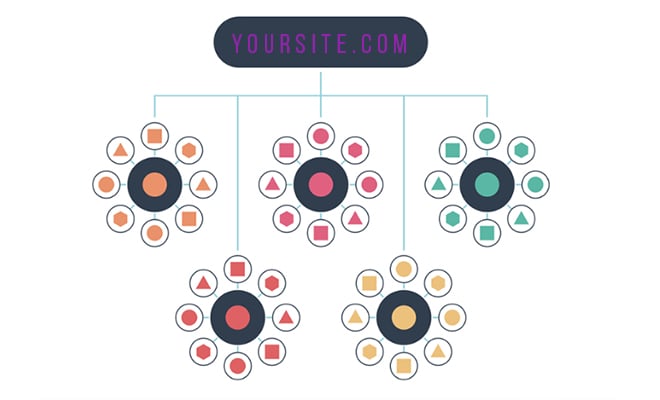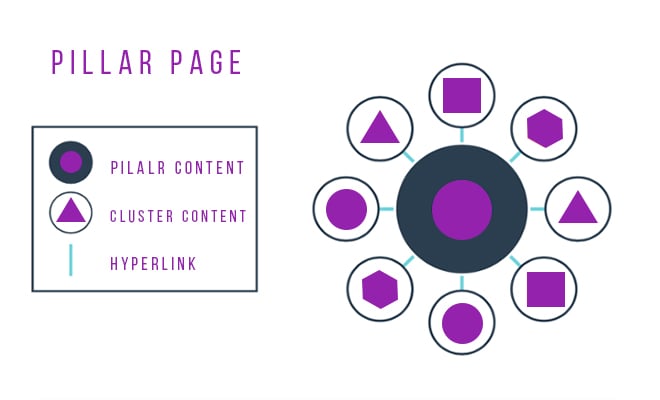Services List
The big bold world of SEO is ever-changing. As soon as you think you've got it under your belt, there will be a Google algorithm update that shakes the ground beneath it. Add stability to your structure with pillar pages. If you're not familiar with what these pages are, don't sweat it — we're here to help you along.

Content cluster, cornerstone content, or pillar page. Whatever you call it, it is important to incorporate this into your blog's architecture. As the name suggests, it is a content piece that holds all the information on a topic which is broken down into sub-pillar sections that branch out into their individual clusters. Confusing? Don't worry, you'll snap into it in a moment.
What Is A Pillar Page?
Why Do I Need A Pillar Page?
How Do I Create A Pillar Page?
What Is A Pillar Page?
People are submitting longer, more conversational search queries and pillar pages cater to just that. Picture yourself before entering a Google search. If you were trying to find a place to eat sushi, would you search for "restaurants," or would you search for "Japanese restaurants near me"?
If you'd go with the second option, you're among the majority: 64% of searches are four words or more, and we're seeing a growing number of these longer-form conversational search queries that help people find the exact information they're looking for.
Now, your site needs to be organised according to different main topics, with blog posts about specific, conversational long-tail keywords hyperlinked to one another, to address as many searches as possible about a particular subject. Enter the topic cluster model.

Why Do I Need To Use Pillar Pages?
Above and beyond creating structure and order to your site's architecture, a pillar page covers all aspects of the topic on a single page, with room for more in-depth reporting in more detailed cluster blog posts that hyperlink back to the pillar page. Pillar pages broadly cover a particular topic, and cluster content should address a specific keyword related to that topic in-depth.
Most organisations use pillar pages for lead generation as well. Since you’ve got all that traffic coming to these pages, it makes sense that you’d want to actually do something with that audience.
Additionally, pillar pages can be an important part of your content marketing efforts like on-boarding, email campaigns, etc.

How Do I Create A Pillar Page?
Choosing A Topic
The first step in building your pillar page is choosing a core topic. It should be specific to your industry and support one of your products or services in the awareness (educational) stage of the buyer’s journey. It should also be evergreen and broad — but not overly broad. Choose a topic that can be broken down into several supporting subtopics.
SEO & Your Subtopics
The next step is to develop a list of subtopics so you can create your cluster. Start by doing some keyword research. Also find out what terms and questions that fall under your main topic umbrella are being entered into Google. Enter your core topic into Google, and see what comes up! Don't forget to look near the bottom of the SERP at the related searches, as well.

Ready, Set, Write!
It’s time to begin the writing process. In general, a pillar page will be much longer than a typical blog post. It will likely be closer to the length of an ebook. Organise your content in a way that makes it easy for your readers to follow and find the information they’re looking for quickly, while keeping your conversion goals in mind at the same time.
Start with an introduction in which you define your pillar page topic and give an overview of what visitors will find on the page. Next, dive into writing about each of your subtopics. Focus on answering questions and writing for the user. Be of as much help to someone researching your topic as you possibly can, using links to other pages on your website to help guide them through the buyer’s journey.
Design It Up!
Next, it’s time to design your pillar page and optimise the content on your website. First of all, you want this page to be ungated; users shouldn’t have to fill out a form to access it. You also want Google to be able to crawl it easily. If you’d like to give users the option to download the information in PDF form so they can save it to read later, consider giving them that option on this page, as well. Include a simple form that allows them to download it quickly and easily in exchange for a bit of contact information (such as their name and email address).
Your page should be a clearly mapped out, scannable guide. Make sure you include each of the following elements as you build it:
- Anchor-linked table of contents
- Near the top of the page
- Functions like the chapters of a book
- Links to main headers throughout your page
- Allows users to find specific sections they’re looking for and “jump” straight to them
- Core topic definition
- Headers
- H1 (title) tag should contain your core topic keyword
- H2 tags for main section headers
- H3 tags (and so on) for additional sub-sections
- Internal links
- Relevant sources that provide more in-depth information on topics
- Link to top-performing pieces on your website that fall within different sections of your pillar page
- External links
- Sources that validate your claims and add credibility
- Images
- Support your content
- Give readers visual aids
- Include alt text
- Back to top button(s)
- Placed in each main section or (at the very least) at the bottom of the page
- Makes it easy for users to jump back to the top of the page
- Saves users from having to scroll!
- Landing page elements
- You still want this page to be focused on increasing conversions, so don’t forget to include a form somewhere so users can contact you for help.
- Calls to action button
- Encourages readers to take an action (like contacting you or downloading more information)
- Use where it’s helpful
- If it looks out of place or interrupts your page flow, it may be better to leave it out.
You should reference your core topic in each of these key areas on the page:
- Page title
- URL
- H1 tag
- Throughout body


-Jan-22-2024-11-04-26-6635-AM.png?width=1200&name=CRM%20System%20(1)-Jan-22-2024-11-04-26-6635-AM.png)

